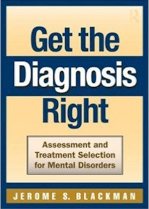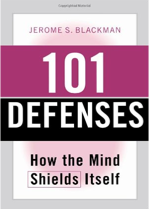Dr. Blackman's Books

Jerome S. Blackman, M.D.
PSYCHIATRIST AND PSYCHOANALYST
Get the Diagnosis Right: Assessment and Treatment Selection for Mental Disorders
Get the Diagnosis Right explains how to make an accurate diagnosis when people have
emotional problems. The DSM's contain collections of symptoms and complaints that can be
organized to form a preliminary diagnosis. The observer, however, can do more than collect
and arrange complaints. Assessment should also be done regarding deficits in important mental
functions (including organizing thought and checking reality), in basic capacities for containing
emotions and impulses, in abilities to sustain close relationships, and in the intactness of the
conscience. If deficits are not found, then internal conflicts among wishes, guilt, emotions, and
defense mechanisms become more important.Get the Diagnosis Right is divided into two sections: "Part I: The Quick and Dirty" and "Part II: The Rest of the Story." Part I, about 50 pages, sets out the major concepts necessary to determine what type of treatment a person with emotional problems should obtain. Part II, about 200 pages, enlarges on Part I, giving more detail and discussing the complications. Both Sections include a template for completing an evaluation, along with charts, tables, clinical examples, and references for further study.

101 Defenses: How the Mind Shields Itself
Defense is the name given to the brain mechanism of shutting elements of feelings out
of consciousness. Defenses are sort of like circuit breakers, acting to relieve overwhelming
emotions, sometimes adaptively, sometimes not so adaptively.
There are two basic defenses: repression, the mechanism that shuts out thought content, and isolation of affect, which shuts out sensations from consciousness. The other 99 listed in this book are essentially "helper" defenses.
When defenses are maladaptive, they create symptoms such as phobias, compulsions, and depressions. They can also contribute to character problems like chronic passivity, obnoxiousness, shyness, and hypersexuality.
101 Defenses, aside from describing each defense and giving multiple clinical examples, also includes chapters on constellations of defenses in pathological states. In addition, other chapters discuss methods for finding defenses, the ways of approaching the defenses both supportively and interpretively, and how to use defense theory in determining suicide risk.

Book Chapters
(2001) On Childless Stepparents.
In:
Stepparenting: Creating and Recreating Families in America Today.
Eds: Cath, S. & Shopper, M. Hillsdale, New Jersey: The Analytic Press.(2002) Shift from Homosexual to Heterosexual Orientation during the Termination Phase of Psychoanalysis. In: Objects of Desire: The Sexual Deviations., Eds. K. Gould, M.D., S. Kramer, M.D., A. Freedman, M.D. & C. Socarides, M.D. Madison, Connecticut: International Universities Press.
(1991) Instinctualization of Ego Functions and Ego Defects in Male Homosexuals: Implications for Psychoanalytic Treatment. In: The Homosexualities and the Therapeutic Process. Eds: Volkan, V. & Socarides, C. Madison, CT: International Universities Press.
Journal Articles (for an off-print, contact Dr. Blackman)
(2003) Dynamic supervision concerning a patient's request for medication.
Psychoanalytic Quarterly 72:469-476.(2000) Bizet’s Carmen on the Couch. Virginia Opera Voice. Fall, 2000.
(1997) Teaching psychodynamic technique during an observed analytic psychotherapy interview. Academic Psychiatry 35:148-154.
(1994) Psychodynamic techniques during urgent consultation interviews. Journal of Psychotherapy Practice & Research 3: 194-203.
(1991) Intellectual dysfunction in abused children. Academy Forum 35:7-10.
(1987) Character traits underlying self-neglect and their connection with heart disease. Journal of the Louisiana State Medical Society 139(2): 31-34.